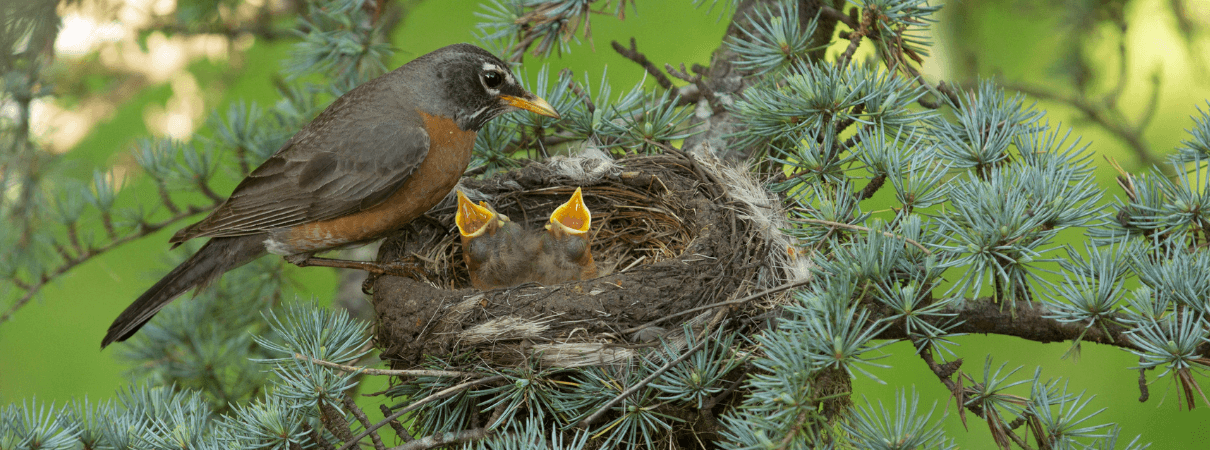How to Help Chicks and Fledglings This Breeding Season

American Robin adult and chicks in nest by Anthony Ricci/Shutterstock
Summer is the peak of bird breeding season in the U.S. and Canada. Both countries serve as bird nurseries for hundreds of species at this time of year. It's also a risky time, and most chicks don't survive to adulthood. Given the loss of nearly 3 billion birds since 1970, American Bird Conservancy (ABC) is encouraging action to help birds survive and thrive. Here are ways to help:
- Leave baby birds alone unless there is an immediate danger.
Helping a young bird — especially one that is learning how to fly — is a very delicate situation. Much like a child learning to ride a bike, a fledgling's first attempted flight isn't always successful. A juvenile bird may look helpless or in need of care, but its parents are likely nearby and keeping an eye on the situation from a safe distance. If you do find a bird that is truly in need of assistance (for example, a chick that is injured or in immediate danger), do not take care of it yourself for any longer than necessary. As quickly as possible, find a local, certified wildlife rehabilitator who has the proper permits, training, and facilities to help the animal.
- Keep pets indoors or supervised when outdoors.
This advice is relevant at any time. Free-roaming pets are natural predators, and can cause stress to chicks and adult birds. When fledglings are learning to fly, giving them space away from curious pets is one of the best things you can do.
Practice and advocate for treating cats like dogs — that is, providing safe and enriching places for pet felines to live indoors full time, or supervised and contained outdoors using a harness, backpack, or “catio.” Learn about other simple actions you can take to protect birds on our Cats Indoors page. If you are a cat owner, you can also pledge to keep your pet responsibly contained.
- Protect birds from glass collisions.
Collisions with glass are a major human-caused threat to young and adult birds alike, killing up to 1 billion individuals annually in the U.S. alone. Because birds see differently than we do, glass poses a serious risk, especially when vegetation or other habitat is reflected in its surface. From tape to screens and films, there are many effective, easy-to-install, and inexpensive home solutions to help reduce bird–window collisions. A great place to start to figure out which solution is best for your home is ABC's collision-preventing products database.
- Garden and landscape with native plants.
Manicured lawns just don't cut it for birds. Sure, you may see an American Robin stop by. But to attract a variety of birds, look for opportunities at your home, school, or business to replace grass with native flowers, shrubs, and trees that support birds as well as the insects necessary for birds' survival. One quick method: Cover grass with cardboard or several pages of newspaper, layer on several inches of soil mixed with compost, and plant!
- Say no to synthetic pesticides.
Pesticides can have both immediate and long-term negative impacts on birds visiting or breeding in your garden. Even though advertising can make common pesticides seem appealing and harmless, by applying them to your garden, you're likely to harm much more than the pests you're targeting. Neonicotinoids (or neonics) — the most widely used insecticides globally — are used as seed coatings and found in products like insect sprays. One seed coated with neonics is enough to kill a songbird, and even less can harm a bird's reproduction. To weed your garden, use your own elbow grease or natural alternatives to chemical-based options. Learn more about organic gardening on our blog.
- Leave it be.
Where it's practical to do so, leave sticks and leaf litter on the ground. A completely clear lawn doesn't provide much cover for birds, especially young ones learning to fly. A less tidy yard will also help create a nutritious layer of compost that enriches the soil. Plant matter also provides the building blocks of bird nests and promotes foraging activity. The longer birds forage in your yard, the longer you get to enjoy them.
- Provide snags for clear sight lines.
You can “plant” a large dead branch in your garden or leave some dead branches in living trees to provide lookout points for birds. You may be surprised how quickly hummingbirds, flycatchers, and other birds adopt these “stick” perches, which help them watch for predators, competitors, and food sources.
- Support birds from inside, too.
You can support birds whether you have a yard or not. Consider purchasing bird-friendly coffee, “reduce, reuse, recycle,” and use your voice by asking your elected officials to support bird conservation efforts.
For more about ABC's top tips to help birds, read how our staff takes action at home.
###
American Bird Conservancy is a nonprofit organization dedicated to conserving wild birds and their habitats throughout the Americas. With an emphasis on achieving results and working in partnership, we take on the greatest problems facing birds today, innovating and building on rapid advancements in science to halt extinctions, protect habitats, eliminate threats, and build capacity for bird conservation. Find us on abcbirds.org, Facebook, Instagram, and Twitter (@ABCbirds).
Media Contact: Jordan Rutter, Director of Public Relations| jerutter@abcbirds.org | @JERutter


















































